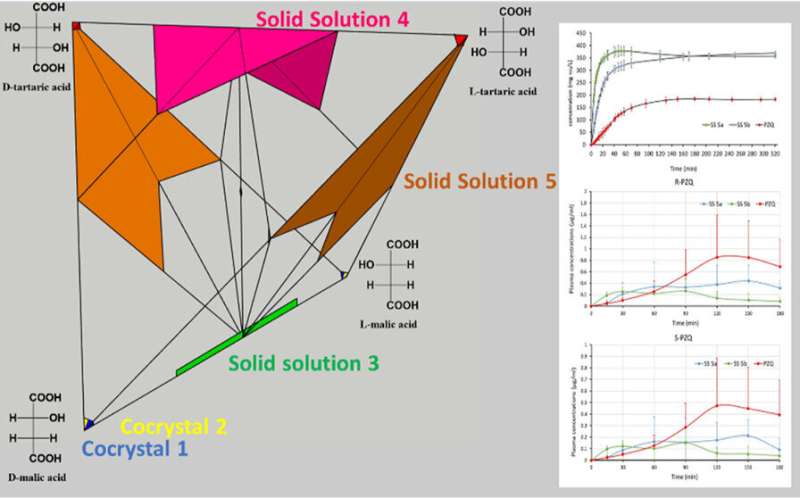This article has been reviewed according to Science X's editorial process and policies. Editors have highlighted the following attributes while ensuring the content's credibility:
fact-checked
peer-reviewed publication
trusted source
proofread
New research could make medicine more soluble and palatable for children

Research conducted at University of Limerick in Ireland has shown that crystal engineering can improve access to a drug used in the treatment of a tropical disease affecting millions worldwide.
The study investigated the potential benefits of an underexplored crystal engineering strategy to improve the properties of crystalline drugs, which in turn would improve drug absorption in the human system.
The strategy was tested on a drug used for the treatment of schistosomiasis, a neglected tropical disease that affects over 250 million people worldwide.
The Centers for Disease Control and Prevention identify schistosomiasis as second only to malaria as the most devastating parasitic disease.
The research was led by Dr. Matteo Lusi, a Lecturer in Crystallography at University of Limerick, who is a researcher in the Bernal Institute in the Faculty of Science and Engineering, along with colleagues in UL, Italy, and Switzerland.
The findings, which could have a significant impact in making medicine more soluble and palatable for children, have just been published in the Molecular Pharmaceutics journal.
Praziquantel (PZQ) is the drug of choice for the treatment of schistosomiasis, a neglected tropical disease that affects 250 million people worldwide.
Due to its low solubility and high permeability, a high dose is required—particularly in children—and the large volume makes it difficult to swallow, which decreases patience compliance and causes many cases to be untreated.
While smaller dose forms are currently in development, they are considerably more expensive—meaning that cheaper strategies to dose reduction using a more soluble form with increased absorption would be desirable.
"This work demonstrates that a solid solution could increase the solubility of the drug by up to eight times and its absorption in vivo—or in the body—which is key to greater efficacy and reduced side effects for the patients," explained Dr. Lusi.
The results were obtained through a simple crystal modification with relatively low development and manufacturing costs, Dr. Lusi explained.
"As a proof of principle, we have focused on an essential drug for the treatment of a parasite that is common in tropical and undeveloped countries, many which cannot afford expensive medicines.
"Our approach is also a more general one that can be applied to any crystalline drug forms. This is also critical to achieving UN Sustainable Development grand challenges in good health and well-being," Dr. Lusi added.
Dr. Lusi, a lecturer in UL's Department of Chemical Sciences and author of over 70 publications who is also the former director of the International School of Crystallography Erice, Italy, has said the goal of his research in this area "is to understand how molecules and ions interact in the solid state or crystals and how molecular and ionic interactions translate into tangible chemical and physical properties."
"Ideally such knowledge can help create new crystalline materials with predetermined properties and functions."
Dr. Lusi's research has investigated a little-known ability of molecules, which behave in a crystal as they do in a liquid form, in that they move, react together, and mix freely to create solutions.
"Crystalline materials are present in most drugs, and agrichemicals. In this sense there is already a considerable interest from pharmaceutical, nutraceutical and agrichemical companies to produce better products that are more stable, bioavailable, easier to produce and administer," the UL researcher explained.
"Such products will also have lower side effects and environmental footprint," Dr. Lusi added.
More information: Chiara Cappuccino et al, Co-Crystalline Solid Solution Affords a High-Soluble and Fast-Absorbing Form of Praziquantel, Molecular Pharmaceutics (2023). DOI: 10.1021/acs.molpharmaceut.2c00984
Journal information: Molecular Pharmaceutics
Provided by University of Limerick




















